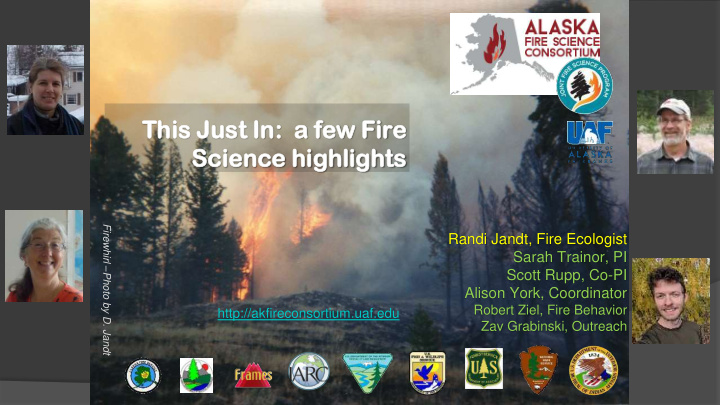



This s Just t In: a few Fire e Science nce highl hligh ghts ts Firewhirl – Photo by D. Jandt Randi Jandt, Fire Ecologist Sarah Trainor, PI Scott Rupp, Co-PI Alison York, Coordinator Robert Ziel, Fire Behavior http://akfireconsortium.uaf.edu Zav Grabinski, Outreach
Boreal fire regime sensitive to T °-- 1925-2019 https://www.ncdc.noaa.gov/cag/statewide/time-series/ Especially summer T °, and the forest floor is one big reason.
Now read this: https://uaf-iarc.org/2019/08/23/alaskas-changing-environment/
More heat = drier fuels = more combustion Photo by Jonathen Hayward, The Canadian Press May 2016 Ft. McMurray Fire Temperature Season Length Ignitions Rainfall Permafrost
Bieniek et al. 2019. (In Review) Lightning variability in dynamically downscaled simulations of Alaska's present and future summer climate. Almost no Journal of Applied Meteorology and Climatology place with >10 days/yr % change June/July lightning 1986-2015 Bu But, , so is lightnin ghtning: g:
Veraverbeke et al., 2017 Lightning Nature Climate Change up 59% Burn Area 180 160 140 120 100 Burn Area up 80 by 55% (or 60 46% with Fuels 40 feedback) 20 0 1980-2004 2050-2074
Longer Fire Season: Shrinking Snow Season Source: Fig. 3.9 Ch. 3, Brown et al., SWIPA April 17 th 2016 — Fire jumped on Knik R near Palmer. 2017. Photo Amy Breen, UAF Statewide snowpack is 1 week later in the autumn and melts 2 weeks earlier in the spring SINCE THE 1990’s.
Shovel Creek fire , 2019-07-09, 16:16 and 17:59. yellow: high intensity, red: low intensity The smaller pixel size reflects the position of the pixel in the swath center. Photo: Shovel Ck Fire, June 27, 2019 by LR Swenson, NW Fire Blog. Courtesy of Robert Ziel & Chris Waigl, UAF
Imagery from Shovel Creek fire , the European 2019-07-09, 16:16 and 17:59. Space Agency’s yellow: high intensity, Sentinel red: low intensity Missions over The smaller pixel size reflects the Chalkyitsik the position of the pixel in the Fire Complex swath center. in Eastern Interior Alaska July 14, 2019. Heavy smoke from the fires obscures the ground in the optical imagery (left), but has little impact on the SAR image (right).
Photo: Renette Saba/Alaska IMT 2019 McKinley Fire ashpits: 6/7 of the large holdover fires in agency records since 2005, were correctly classified by their new algorithm Photo Amy Breen, UAF as overwintering fires. In addition, they discovered 9 large overwintering fires that were not reported by agencies between 2002 and 2018 in Alaska!! A results paper is currently in preparation.
Excellent recorded presentations from the meeting on our Vimeo site! Rachel Loehman, USGS, Alaska Science Center https://vimeo.com/channels/alaskafirescience Carson Baughman, USGS, Alaska Science Center
Webinar - Arctic Urban Risks and Apr 1, 2020 11:00 am Adaptations (AURA) Jen Schmidt, UAA Webinar -The environmental legacies Apr 7, 2020 11:00 am of tundra fires in the Noatak River Ben Gaglioti, UAF Valley of Alaska Webinar - Evaluating Flammability of Apr 16, 2020 10:00 am Reburns in the Boreal Forests of Brian Buma and Katherine Hayes, Interior Alaska University of Colorado March 30 th SMAP Drought Code Webinar-Discussion, with Laura Bourgeau-Chavez and team Remote Sensing Research to Operations Workshop in May- POSTPONED until 2021, with NASA ABoVE Science Meeting in Fairbanks. THANK YOU FOR JOINING THE AFSC FIRE SCIENCE WORKSHOP TODAY! Help us do better by filling out the survey which will come to your inbox.
Recommend
More recommend